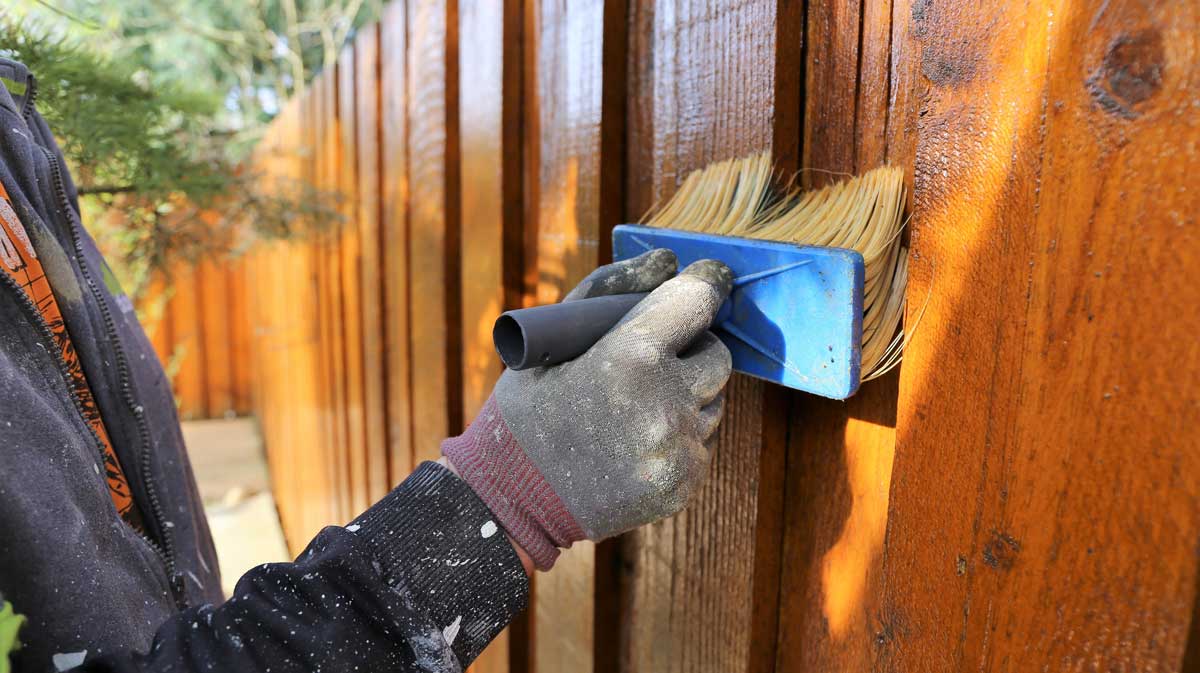Just How to Select the Right Fencing Discoloration for Your Home
When it involves improving the look and toughness of your home's fence, picking the ideal tarnish is an important choice that requires cautious consideration. With a myriad of alternatives offered on the market, each providing to different wood types, colors, and openness levels, the procedure can quickly come to be frustrating. Making an informed selection can substantially impact the general aesthetic appeals and longevity of your fencing. Just how can you guarantee that you select the perfect fencing discolor that aligns with your residential or commercial property's design and upkeep demands? Allow's discover some crucial elements to direct you in this decision-making procedure.
Comprehending Wood Kind
To select the proper fence stain, it is important to have an extensive understanding of the various kinds of wood typically utilized for fencing. The selection of timber plays an important function in determining the durability and total aesthetic appeals of the fencing. Cedar is a popular option due to its natural resistance to decay and bugs, making it a resilient choice for outdoor frameworks. Pine is an additional common timber used in fencing, recognized for its cost and convenience of staining. Nevertheless, pine is a lot more vulnerable to bending and decomposing compared to cedar. Redwood is a high-end option recognized for its striking look and natural toughness, though it features a higher cost tag. When picking a fencing stain, it is very important to take into consideration the kind of wood being made use of to guarantee compatibility and ideal defense. Recognizing the features of different wood types will aid you make an educated decision when it concerns choosing the best fence discolor for your property - Fence Staining Near Me.
Selecting the Right Shade
Selecting a proper color for your fencing tarnish is a critical decision that significantly influences the general visual charm of your property. Lighter colors such as whites or light grays can make a fence show up larger and add a touch of beauty to your residential or commercial property. Inevitably, the appropriate shade option will improve the elegance of your fencing and boost the overall curb allure of your home.

Considering Transparency Levels
When picking the right color for your fencing tarnish, another vital aspect to think about is the degree of openness that will finest fit your property's aesthetic and maintenance needs. Transparency levels in fence spots generally fall under three classifications: transparent, semi-transparent, and solid. Transparent discolorations permit the natural charm of the wood to show via while supplying marginal protection versus the aspects. They are optimal for brand-new or well-kept fences where showcasing the timber grain is a priority. Semi-transparent discolorations use a balance in between shade enhancement and protection, permitting some timber grain to be noticeable while providing modest securing from UV rays and moisture. Solid spots, on the other hand, offer the most protection as they totally cover the wood with an opaque surface. These appropriate for older fences or those looking for considerable security or color change. Consider the degree of direct exposure your fencing deals with, the wanted upkeep regularity, and the visual you wish to accomplish when selecting the appropriate openness level for your fencing discolor.
Reviewing Maintenance Requirements
Thinking about the longevity and upkeep of your fence, examining the upkeep requirements is important in identifying one of the most appropriate fencing discolor for your residential or commercial property. The level of maintenance required for your fencing can vary depending on factors such as the kind of wood, climate conditions in your location, and your personal choices.
When reviewing upkeep demands, it is necessary to think about the longevity of the fencing discolor. Some discolorations call for even more constant reapplication than others, so selecting a stain with a much longer lifespan can aid reduce the total maintenance needs of your fencing (Fence Staining Service). Furthermore, aspects such as resistance to UV rays, water, and mildew can impact how typically you require to re-stain your fence

Checking Examples Before Application
Before using any kind of fencing tarnish, it is suggested to perform example tests to ensure compatibility with the wood and preferred aesthetic outcome. Evaluating examples enables you to evaluate exactly how the tarnish will certainly communicate with the specific type of wood utilized in your fencing, as different woods can absorb spots differently. To start, pick a little low-profile Fence Staining Nashville TN area of the fencing to use the tarnish examples.
Verdict
Finally, selecting the proper fencing discolor for your residential or commercial property entails comprehending the timber kind, picking the best shade, considering transparency levels, evaluating upkeep requirements, and screening samples prior to application (Fence Staining). By taking these factors into factor to consider, you can make certain that your fence discolor complements your property while supplying the needed defense and toughness. Make an informed decision to enhance the appearance and durability of your fence